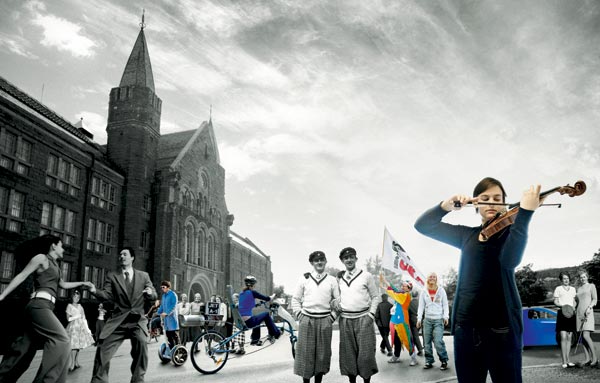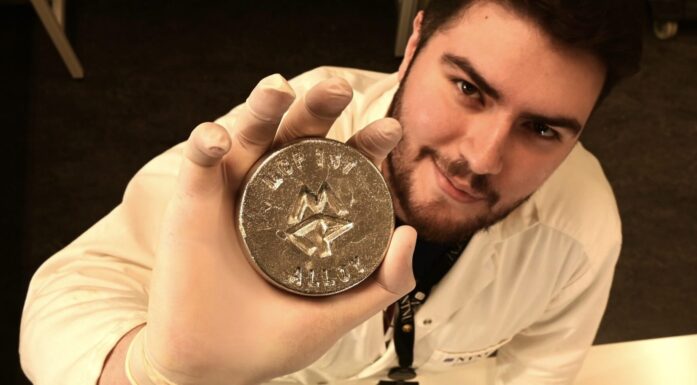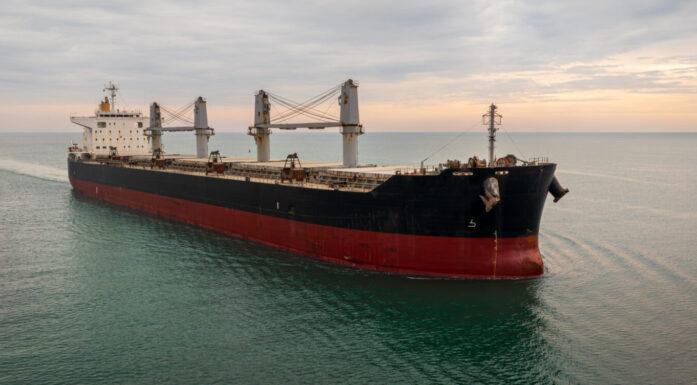The future factory
A one-hundred-year old institution is celebrating its centennial. But what’s the larger historical significance of this milestone?

Real Madrid and Chelsea football clubs train using the interval 4X4 method developed by NTNU Professors Jan Helgerud and Jan Hoff.
It has been ‘One Hundred Innovative Years’ since the Norwegian Institute of Technology (NTH) opened in 1910. But in the context of Trondheim, 100 years really isn’t that long. Biology and archaeology as academic disciplines in the city have more ancient roots, because the two disciplines are linked to the founding of the Norwegian Academy of Science and Letters in Trondheim 250 years ago. Nevertheless, a thorough understanding of NTNU’s larger historical significance demands a close look at NTH.
Fish fingers and more
Just one look at the list of graduates from NTH over time shows how important the institution has been in providing leadership to Norway’s industries and the technical sciences. Here are the individuals behind everything from the motorization of the Norwegian fishing fleet and the optimization of power plant turbines, to the invention of methods for drying and freezing fish.
Gustav Lorentzen is on the list. He conducted pioneering research in freezing technology at NTH, and may in some sense be seen as one of the fathers of fish fingers.
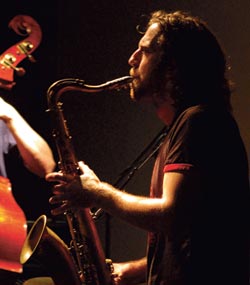
NTNU-trained jazz musicians have won recognition in 2005 and 2006 as the best young international jazz talent, and NTNU music graduates contributed to four Grammy-nominated performances in recent years.
Another is Einar Brendeng, the man who was instrumental in opening Snøhvit, the giant gas field in the Barents Sea in northernmost Norway, by developing the technology that allows liquefied natural gas to be transported by ship in spherical refrigerated tanks. NTNU and SINTEF scientists and engineers have also worked on the multiphase transport of oil and gas, which is a shining example of how profitable it is to invest in research – especially if someone else pays for it.
Just naming three to four leading scientists from one of NTNU’s more than fifty departments easily illustrates the importance that NTNU and NTH have had in the development of Norway as we know it today.
Adventurous engineers
It was by no means a given that the Storting would select Trondheim as a location for the new technical college at the turn of the 20th century. Oslo, then Kristiania, was a tough challenger. Kristiania had many advantages – it was close to the seat of government, to the university and its many laboratories, and to what had been the country’s major centre for industrial growth over the 1800s. In contrast, what did Trondheim have?
Well, first and foremost, Trondheim had eloquent spokespeople. Venstre Party member and theologian Vilheim Andreas Wexelsen used the technical college’s potential as a driver of industrial development, along with Trondheim’s excellence, as a persuasive argument in the Storting.
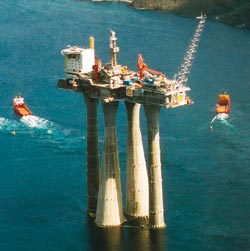
Concrete platforms: The 34 giant Condeep oil platforms in the North Sea are an outgrowth of NTNU expertise in concrete technology, structural engineering and large project organization.
In his closing speech in the parliamentary debate over the location of the new technical college, Wexelsen “preached in favour of Trondheim, with so much pastoral anointing that the representatives from Trondheim stood with tears in their eyes and a lady in the gallery fainted,” according to a summary of the proceedings.
But the Trønder capital also had something concrete to support Wexelsen’s pretty words. There had been technical education in Norway before NTH, and the best were already in Trondheim. The education of skilled technicians took place at the country’s institutions for technical training in Bergen, Kristiania and Trondheim. But in 1895, the Trondheim Technical Vocational School (TTL) had been extended to a four-year education with different disciplines. Many of the engineers educated in Trondheim went out into the world, in a spirit of adventure and out of desire rather than of necessity. They built skyscrapers in Chicago, dams in South Africa and the railway in Chile.
Young and energetic
In fact, while NTH was not a driving force for new industry at first, there was nevertheless a great deal of useful research at the new institution. Even the architects conducted research: Andreas Bugge’s many test houses at Gløshaugen in the 1920s provided a longitudinal study of insulation, building materials and home construction. The connection to the ‘smart homes’ of today, and to zero emission buildings is quite clear.

Ugelstad beads: NTNU Professor John Ugelstad perfected a way to make perfectly round, perfectly uniform microscopic beads in 1977. These tiny magic beads have come to play a vital role in different medical diagnostics and treatments.
Many of the new professors were fresh from university with doctoral degrees from Germany, like Watzinger, or like the physics professor Sem Sæland, who was only 35 years when he became rector in 1910. Sæland was a youthful driving force and was perfect for the new institution. The students loved him, his colleagues respected him, and everyone in the Norwegian Storting knew of his powerful ability to argue his point.
Together with local supporters, Sæland managed to get the Storting to finance the building of a new physics laboratory in the 1920s. It was a great achievement during a time of economic crisis for the country.
Advances in radio
The interwar period was marked by many scientific breakthroughs. This was the golden age, especially for physics.
Sæland’s successor, John P. Holtsmark, was a nuclear physicist of international stature. He attracted many of the cleverest students from other departments. Holtsmark and his assistants decided to tackle radio technology. It may sound strange, but radio was then high technology. Among Holtsmark’s many talented students was Vebjørn Tandberg, who later founded a Norwegian electronics empire under his own name.
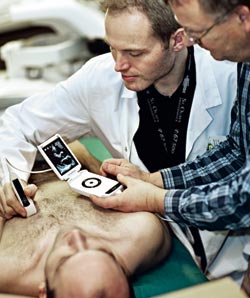
A handheld ultrasound device: The Vscan, developed by researchers at NTNU, SINTEF and St. Olavs Hospital in cooperation with Vingmed Sound, is the world’s first handheld ultrasound device.
Holtsmark and Tandberg developed a portable reverberation meter. It was used for field studies of acoustic properties in movie theaters, concert halls and assembly halls. With microphones, amplifiers and speakers, the reality of modern media changed. Now, buildings had to be adapted to the new age of sound. Holtsmark was also involved in an important social task: building Norwegian broadcasting. In fact, the technical development of the Norwegian Broadcasting Corporation (today’s NRK) in the 1930s involved many scientists and engineers from NTH.
Tronstad and heavy water
The coming of the Second World War and the invasion of Norway by the Nazis affected everything, of course. But virtually everyone – Germans and Norwegians alike – wanted NTH to carry on. There were changes – active contact with international researchers stopped. And some NTH professors, like resistance leader and chemistry professor Leif Tronstad, barely escaped the Gestapo and went to London.
Tronstad had been active in the resistance since the Germans first invaded Norway on 9 April 1940, and his office at NTH was described as a hotbed of illegal work. More significantly, however, Tronstad had made important discoveries in the 1930s about heavy water (deuterium oxide), and had helped Norsk Hydro, then producing fertilizer, to build a heavy water plant at Rjukan. He consequently became central in the planning of sabotage against the same factory to prevent the Germans from using the heavy water for nuclear weapon development. The story was famously documented, if somewhat inaccurately, in a Hollywood movie entitled ‘The Heroes of Telemark.’

A sense of where we are: May Britt and Edvard Moser’s Centre for the Biology of Memory and Kavli Institute for Systems Neuroscience discovered grid cells in the brain, which help with your sense of location.
What is less widely known is that Tronstad laid much of the foundation for the development of Norwegian technical and scientific research after the war. Tronstad was one of the most influential Norwegians in London, with contacts at the highest level among both scientists and military leaders. Thus, Norwegian engineers and scientists were included in a number of the Allies’ major projects.
The link between research, industry and defence technology resulted in great advances. Radar, sonar and other electronics were among the innovations that grew out of the war. Afterwards, these developments gave Norwegian scientists and engineers valuable experience to build on. Unfortunately Tronstad himself never lived to see the fruits of these efforts. He was killed in battle in March, 1945.
Oil!
Towards the end of the 1950s there began to be a growing interest in the waters off England, the Netherlands, Denmark and Norway. But there were few, if any, who saw the value that lay hidden there. And with the exception of a few platforms in the Gulf of Mexico, there were not many companies that had experience with oil production in deep water – at least not in an area as rough as the North Sea.

GSM Mobile phone technology: In 1987, the Global System Mobile – GSM – communications system, developed by researchers at NTNU and SINTEF won a competition in Paris that led to the system being adopted as the worldwide standard for mobile phone technology.
Yet when North Sea oil was finally discovered, NTH’s leadership, led by Rector Johannes Moe, made certain that petroleum-related studies were expanded in record time. Virtually all departments at NTH were influenced by the oil age. The mineral resources department, once one of the smallest in both size and status, became responsible for petroleum engineering. It was a prestigious subject, and there were some interesting cultural encounters between the new men of the Oil Age, with their briefcases and suit jackets, and the traditional minerals and mining students in their grubby miner’s clothing.
New cards, new technologies
Although oil on the Norwegian continental shelf was first produced with foreign expertise, Norwegian technology and knowledge rapidly came to the fore, especially because of expertise at NTH in marine technology and concrete structures. NTH’s opening of a ship model tank in 1939 – ironically used by the Nazis to store potatoes during the war years – became an important basis for the transition from shipbuilding to offshore structures forty years later.
Few factors have had a greater impact on developments in Trondheim than the new oil economy. There are also few, if any, areas where Trondheim’s research communities have contributed more to Norwegian growth and prosperity.
Life without music
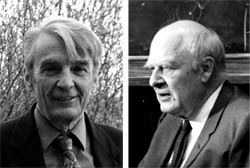
NTNU Nobel laureates: Lars Onsager, Nobel Prize in Chemistry in 1968. Ivar Giæver, Nobel Prize in Physics in 1973.
The hunt to understand NTNU’s historical significance could end where much of the technical institute’s early history was written, in the Department of Energy and Process Engineering. These days, the department’s researchers are critical to achieving Norway’s self-stated ‘lunar landing’, the Holy Grail that is CO2 capture and storage. Much of Norway’s energy future is being developed here in Trondheim.
But the university’s historical significance is so much more than providing for the practicalities of everyday life, and NTNU is much more than the old NTH. The search for new knowledge and understanding is fundamentally meaningful, and much of what gives life meaning is being explored at NTNU. As Nietzsche so correctly put it, “Life without music would be a mistake.” Performing artists and musicians are an important part of NTNU’s profile, and the university’s importance should not be reduced to solely providing the tools for growth and prosperity. Linguists, social scientists and other cultural disciplines also belong in a broader history than we have room for here. Indeed, NTNU’s true historical contribution to Norway is in this, its academic diversity and tradition of useful curiosity.
Thomas Brandt and Ola Nordal
